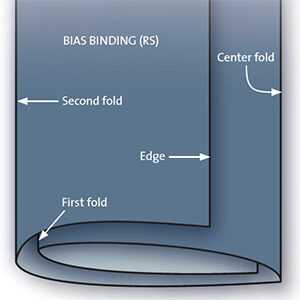Pro Techniques for Applying Bias Binding | Video

Bias binding is a functional and attractive finish for garment edges. It can replace facings and hem allowances, and add definition to the garment’s silhouette. It’s also a useful finish for quilts, accessories such as bags and purses, and home décor items such as slipcovers and pillows. Threads author Daryl Lancaster shows where and how to apply bias binding in this in-depth video tutorial.
Daryl begins by showing how to join the ends of bias strips to create a strip long enough to cover the perimeter of a garment. She then shows where to begin binding. Typically, you should begin at the longest and/or straightest stretch of any edge; the center-back hem or the back of an armhole are good starting points. You’ll find it easier to join the strip’s two ends when you have sewn it to the edge.
You’ll learn how to miter corners as you attach the binding, how to join the ends by machine, with on-grain seams, and how to finish the binding on the opposite side. You can sew by hand or use a straight, zigzag, or decorative machine stitch. A useful tip is to skip pinning the bias to the garment’s edge. Daryl explains that the bias stretches somewhat when it is being sewn, and it is better to let it stretch as needed than to force it into a particular length or shape by pinning.


































Phenomenal. Thank you!
Such a polished presentation. Are there any advantages this method has over sewing the bias to fit the round (by measuring the pattern and then cutting and joining bias before attaching). Also some sewers don't join the bias on a bias line but a straight grain. What is your opinion? Thank you Daryl.
MissMarie, I find that by allowing the bias to flex during the application, rather than pre-pinning and joining, especially on the lengthy perimeter of a garment involving mitered corners, you'll get a better more accurate result. Since bias has flexibility, it needs to be allowed to move under the presser foot pressure as it is applied.
In the demonstration, I joined the bias on the straight of grain, which is pretty essential for stability, though it might have been confusing visually. The two bias strips were pinned together right sides together, at right angles to each other, and the actual stitching was diagonally across the connection, which is in reality the straight of grain.
What a thorough and marvelous in-depth demonstration and explanation--excellent! Thank you so much. I've only just felt confident to start using bindings and will definitely be referring back to this video when edging garments.
Daryl, your response is appreciated. I have had mixed success with binding over many years - there are so many ideas not to mention single and double fold. I will give your method a go and send you a photo of the result. I feel that it will be professional as your instructions give confidence. I did understand your joining method - I didn't give the best description of what I saw someone else do
Marie.
I feel that Wendy Butler in a Quilting program on Craftsy has a much easier way to join the ends of bias binding, You might want to check it out
What a great presenter! Exact language, brevity and clarity! This is how you should do all your videos, have someone TAKE THE TIME and really explain the technique. Thank you!
Hi Daryl! Thank you for a concise and informative video. Some of your beautiful finished garments show a very clean and stylish zipper front closure. Can you tell me briefly how you insterted your zippers with the binding elements? Or is there a tutorial that I can refrence for this detail? It is a lovely contemporary look!!
Best Regards🌻
What an incredibly useful and very well presented video.
The only thing I would take issue with is placing the bias join in the middle of the back. I prefer to place it under my left side as when the garment is worn, the join will be hidden by my handbag, leaving a nice, clean line across the back. area, which is more visible.
In any event, the video has inspired me to bias finish the jacket I'm about to make.
Great instructions, I struggle with binding curves but this video helps but I’d like the wooden tool is it an orange stick / wood knitting needle or called something else? I’ve been using a pin... to help move fabric around on the plate..
thanks